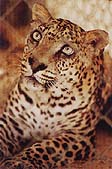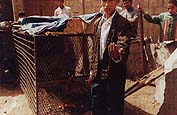JOINS BREEDING PROGRAM
by Marijcke Jongbloed
Pictures by Wood & Gross
 Regular readers of Arabian Wildlife magazine have been following the ongoing saga of the Arabian leopard that was being exhibited in dismal circumstances in the streets of Sana'a, Yemen.
Regular readers of Arabian Wildlife magazine have been following the ongoing saga of the Arabian leopard that was being exhibited in dismal circumstances in the streets of Sana'a, Yemen.
It was in April 1994 that this leopard was first mentioned in Yemen Times in an article by Dr. Denis Harvey: "...a leopard in a cage less than six feet square. It is alive, and you can pay five rials to look at it. Small boys poke sticks and throw stones at it and it cannot move far enough even to take exercise. It is slowly dying of neglect, malnutrition and exploitation..."
When the Arabian Leopard Trust heard about the Yemen leopard, plans were made immediately to try to acquire this leopard for the breeding programme. (One of the four objectives of the ALT is to provide optimal conditions for captive endangered animals to produce offspring, e.g. bring together lone specimens for the purpose of breeding).
Unfortunately, the civil war broke out in Yemen and all plans were on hold for a while. When the dust settled in Sana'a and it was discovered that, surprisingly, the leopard was still alive and well, renewed efforts were made to obtain an export license. This proved to be extremely difficult, mainly because too little was known about the ALT in Yemeni government circles. Officials feared that the ALT was a front for animal dealers and repeatedly refused our requests. A breakthrough came early in 1995, when Dutch diplomats interceded and organized meetings with the Yemen consul in Dubai and a visiting deputy minister of the Ministry of Agriculture. A few weeks later, ALT-coordinator Marijcke Jongbloed travelled to Sana'a to participate in an environmental workshop, organized by the Environment Protection Council. During that visit, EPC's Dr. Mohammed al Mzashgari and his team of hardworking colleagues set up meetings with all the concerned officials, which led eventually to the signing of a breeding loan agreement between Yemen and the ALT on March 13, 1995.
However, another hurdle remained. The owner of the leopard, a tribal hunter, first upped his asking price to US $3000, and then refused to sell at all. In spite of continued efforts by the EPC team negotiations bogged down completely. Eventually, after a great deal of effort and support by friends of ALT, this impasse was solved and the leopard was acquired.
Although everyone who has been involved with this venture feels that NO money should have been paid at all, in this case purchase seemed the only option. Hopefully in the near future laws will be implemented in Yemen that forbid the capture and trade of endangered wild animals and the demeaning practice of putting wild animals on show for entertainment will come to an end!
Following its acquisition, the leopard was collected and temporarily housed - in his travelling box - at the Sheraton Hotel (the General Manager generously gave up his balcony!). At this point the EPC team came into action again, and within hours the travelling papers were in order. All in all, by the time the leopard was air-freighted to Dubai, the exercise cost ALT, with some help from its sponsors, almost US $10,000 - a high price to pay for a cat! But given the rarity of the Arabian leopard and his importance as a source of wild genes for the breeding program, probably not too much.
 The end result is all that matters. The leopard now resides in what Christian Gross (who undertook the successful mission to purchase the leopard and who is now caring for it ) calls his 5-star hotel!. He is remarkably tame, having responded immediately to kinder treatment. The eye infection, that plagued him for years due to the filthy conditions he was living in, subsided quickly. He is younger than we thought, having been caught together with his mother, who was killed at that time. He must have been less than one year old then, and has probably been in captivity for about two years. An official name was picked for him from a competition among young ALT-members: Nimrod Felix - the first name a play on the local Arabic word for big cat, nimr , and with the appropriate meaning of 'hunter', while the second name is given in honour of his country of origin (Arabia Felix) and indicating that he is now a 'happy' cat!! But he responds only to Christian's pet-name for him - Noldi!
The end result is all that matters. The leopard now resides in what Christian Gross (who undertook the successful mission to purchase the leopard and who is now caring for it ) calls his 5-star hotel!. He is remarkably tame, having responded immediately to kinder treatment. The eye infection, that plagued him for years due to the filthy conditions he was living in, subsided quickly. He is younger than we thought, having been caught together with his mother, who was killed at that time. He must have been less than one year old then, and has probably been in captivity for about two years. An official name was picked for him from a competition among young ALT-members: Nimrod Felix - the first name a play on the local Arabic word for big cat, nimr , and with the appropriate meaning of 'hunter', while the second name is given in honour of his country of origin (Arabia Felix) and indicating that he is now a 'happy' cat!! But he responds only to Christian's pet-name for him - Noldi!
Nimrod Felix has now been joined by a female, kindly loaned from the Breeding Centre in Oman, where three pairs of cubs have been born in the last five years. Another unrelated male resides in a private collection in Dubai, and can hopefully be mated with offspring in the future.
In the wild, sizeable populations of Arabian leopards remain in the Asir mountains in North Yemen and Saudi Arabia, in the Hadhramaut mountains of South Yemen and the Dhofar area around Salalah in Oman, with very small populations roaming the Musandam and Hajar mountains of Oman and the UAE, and the Negev and Judean deserts of Israel.
Web Links | Subjects | Search
Arabian Wildlife. Volume 2, Number 3